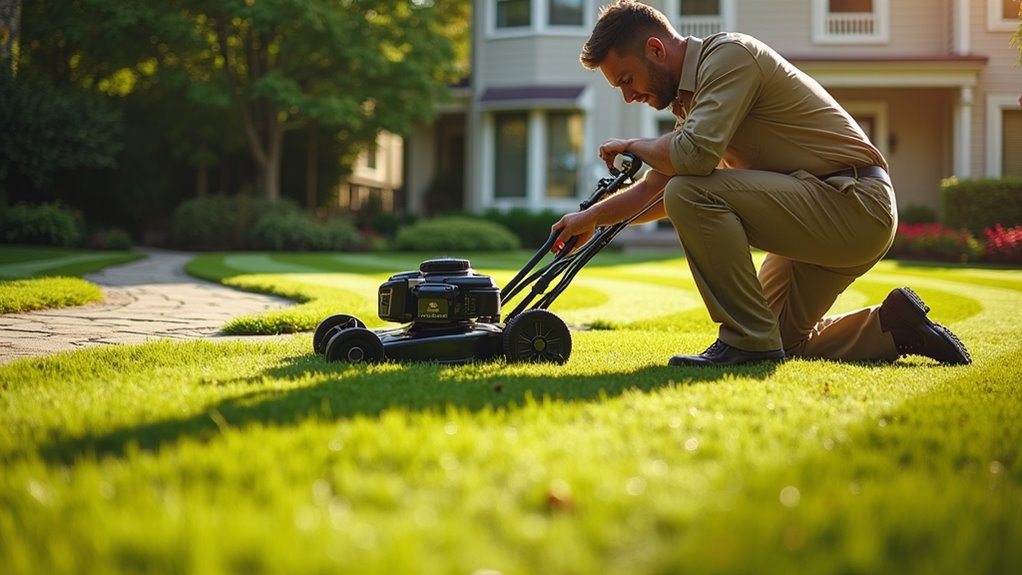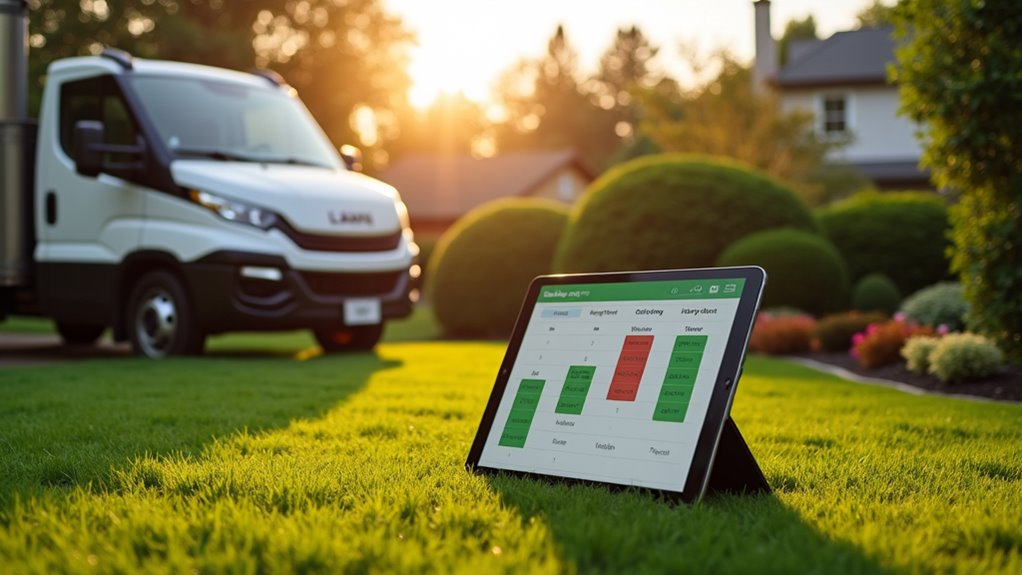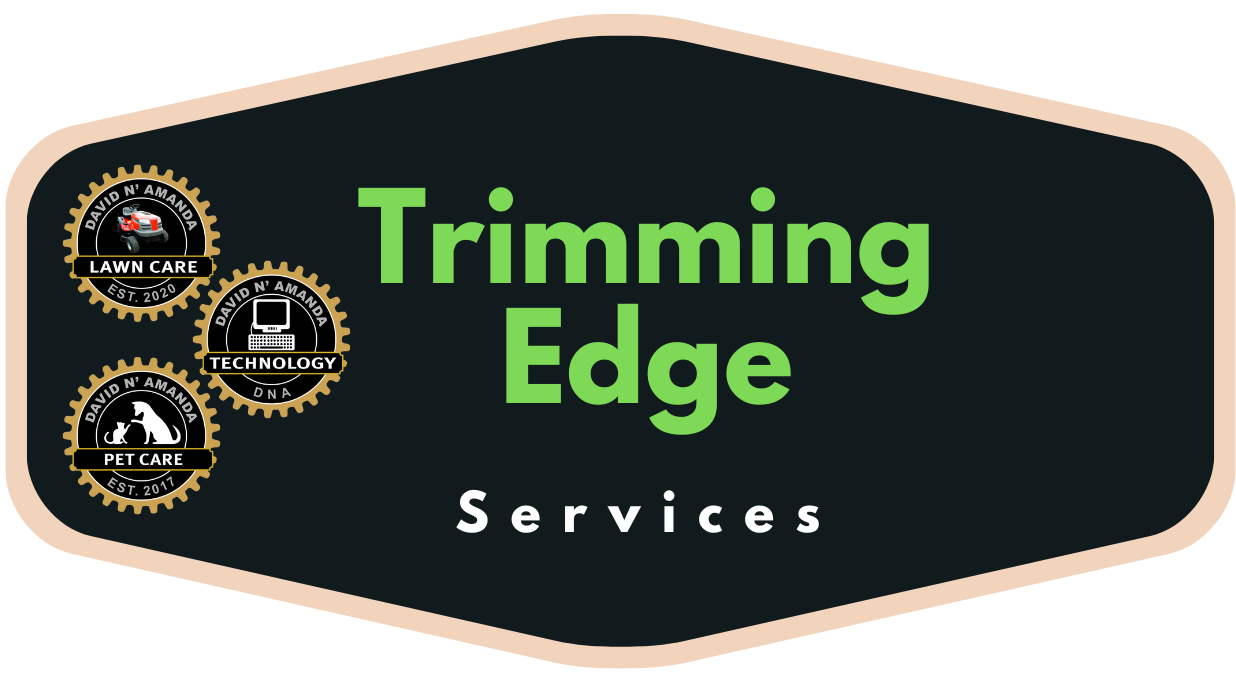You’ll want to price your lawn care services between $45-75 per visit for properties under 8,000 sq. ft., and $75-125 for larger properties up to 10,000 sq. ft. in 2025. Consider offering monthly packages at a 15-25% discount to secure regular clients. Premium services can command 40-60% higher rates, while eco-friendly options typically earn a 20-30% premium. Your specific market conditions and operational costs will help determine where you’ll position your rates within these ranges.
Current Market Trends Affecting Lawn Care Pricing

As the lawn care industry continues to evolve, several key market trends are reshaping service pricing for 2025. You’ll need to evaluate rising equipment costs, fuel prices, and labor expenses when setting your rates. Consumer preferences are shifting towards eco-friendly services and sustainable practices, which often command premium pricing.
Economic fluctuations have created a dual market where some clients seek premium, all-encompassing care packages while others prefer basic maintenance options. You’re also facing increased competition from tech-enabled service providers who use automated scheduling and dynamic pricing models. Supply chain disruptions continue to impact operational costs, while heightened environmental regulations require further investments in compliant equipment and practices. These factors directly influence your pricing strategy and profit margins in the contemporary lawn care market.
Essential Cost Factors to Consider When Setting Rates
Building on these market dynamics, successful lawn care pricing requires a systematic analysis of your operational expenses. You’ll need to factor in both direct costs and overhead while considering regional differences that impact your bottom line. Client preferences in different markets will also influence your pricing structure and service offerings.
- Calculate your equipment costs, including purchase/lease payments, maintenance, fuel, and replacement schedules typically 15-25% of total operating expenses
- Account for labor expenses by determining hourly rates, benefits, insurance, and training costs – usually 40-50% of service pricing
- Factor in overhead costs like marketing, office expenses, vehicle maintenance, and insurance premiums – approximately 20-30% of your rate structure
Review these components quarterly to guarantee your pricing remains competitive while maintaining profitability in your specific market.
Average Price Ranges for Basic Lawn Maintenance

Basic lawn maintenance services in 2025 will cost you between $45-75 per visit for an average residential property under 8,000 square feet. You’ll find most companies offering single visits at the higher end of this range, while monthly service packages typically reduce the per-visit rate by 15-25%. Your location, property size, and service frequency will determine where your costs fall within these ranges, with urban areas commanding premium rates.
Residential Per-Visit Pricing
When evaluating residential lawn care services in 2025, homeowners can expect to pay between $45-75 per visit for properties under 5,000 square feet. Your actual costs will vary based on lot size, service frequency options, and regional market conditions.
To understand residential pricing strategies, consider these key factors:
- Weekly service plans offer the best value, typically providing a 15-20% discount compared to bi-weekly or one-time visits
- Properties between 5,000-10,000 square feet command $75-125 per visit, with premium services like edging and blowing included
- Service frequency options affect your bottom line – you’ll save around $200-300 monthly by choosing bi-weekly over weekly visits during peak growing seasons
Remember to factor in seasonal rate adjustments and package deals when calculating your annual lawn care budget.
Monthly Service Packages
Monthly service packages offer a cost-effective alternative to per-visit pricing in 2025’s lawn care market. For residential properties under 5,000 square feet, you’ll find monthly packages ranging from $175-$225, which typically include weekly mowing, edging, and basic cleanup services.
Properties between 5,000-10,000 square feet command $225-$325 monthly, while estates over 10,000 square feet start at $350. Most providers offer customizable service options, allowing clients to incorporate seasonal treatments, fertilization, or pruning for an extra fee.
To enhance revenue, implement client loyalty incentives such as 10% discounts for 12-month contracts or bundled service upgrades. Consider offering premium packages that include spring/fall cleanup, aeration, and pest control, which can elevate monthly values by 30-50% over basic maintenance plans.
Premium Service Package Pricing Strategies
Premium lawn care packages command 40-60% higher profit margins than standard services, making strategic pricing essential for maximizing revenue while delivering exceptional value. When structuring your premium offerings, focus on bundling high-value services that improve customer loyalty while justifying premium pricing.
- Calculate your base service costs and multiply by 2.5-3x to set premium package rates that reflect exclusive features like specialized fertilization, seasonal color rotations, and detailed edging work.
- Include quarterly yard evaluations and priority scheduling to differentiate your premium features from standard service tiers.
- Build in a 15-20% margin buffer to accommodate rising equipment and labor costs through 2025 while maintaining profitability on premium contracts.
This tiered approach helps you capture high-value clients while establishing your brand in the luxury lawn care market.
Seasonal Rate Adjustments and Special Offers

Your lawn care business can enhance revenue by implementing strategic seasonal pricing, with peak summer rates commanding a 25-30% premium over baseline prices. You’ll find significant opportunities to maintain client relationships during off-peak months by offering bundled maintenance packages at 15-20% below standard rates. Holiday-specific promotions, such as pre-spring cleanup discounts and end-of-season deals, can help you capture an extra 10-15% in annual revenue while maintaining steady workflow throughout the year.
Peak Season Premium Pricing
During peak growing seasons, lawn care companies typically implement surge pricing models that increase base rates by 15-30%. This seasonal pricing strategy helps manage high demand while maximizing revenue during the busiest months. You’ll find that most successful lawn care businesses adjust their premium offers based on local market conditions and service demands.
To implement peak season pricing effectively:
- Monitor your competitors’ rates during May-August and adjust your pricing to maintain competitive advantage while capturing premium value
- Structure your contracts to clearly communicate peak season rates, ensuring transparency with a minimum 30-day notice for rate changes
- Offer early-booking incentives to clients who commit to full-season services before peak periods begin
This dynamic pricing approach helps you optimize profitability while maintaining customer relationships through transparent communication and value-based service delivery.
Off-Season Package Deals
Most lawn care businesses maintain consistent revenue streams by offering off-season packages at 20-40% below peak rates. You’ll enhance your winter income by creating bundled services that combine leaf removal, pruning, and winter lawn treatments.
Service Type | Off Season Discounts
————-|——————–
Basic Mowing | 25% reduction
Leaf Cleanup | 35% reduction
Pruning | 30% reduction
Full Package | 40% reduction
To remain competitive while maintaining profitability, structure your off-season discounts based on service combinations. Consider offering a “Winter Ready” package that includes fall aeration, overseeding, and leaf removal at a 35% discount. You can also create early-bird specials for clients who commit to next season’s services during the winter months, securing advance bookings while providing attractive savings.
Holiday Service Specials
Professional lawn care providers can improve holiday revenue through strategic seasonal promotions that align with major holidays and local events. You’ll find that offering holiday lawn packages with festive discounts can attract new customers while retaining existing ones. By structuring your pricing to reflect seasonal demand, you’re positioning your business for increased profitability during peak celebration times.
- Offer 15-20% discounts on pre-holiday cleanup services during Thanksgiving and Christmas seasons, when property aesthetics become particularly significant to homeowners
- Create bundled packages combining basic maintenance with holiday-specific services like decorative mowing patterns or leaf art designs
- Implement early-bird booking incentives for spring holiday preparations, offering 10% off to customers who schedule Easter and Memorial Day services in advance
Pricing Models: Flat Rate vs. Square Footage
When deciding how to price lawn care services, companies typically choose between two primary models: flat rate pricing or square footage-based calculations. You’ll need to weigh the flat rate advantages, including simplified billing and predictable revenue, against square footage considerations that account for property size variations.
| Feature | Flat Rate | Square Footage |
|---|---|---|
| Billing | Simple | Complex |
| Revenue | Predictable | Variable |
| Scalability | Limited | High |
| Customer Appeal | Fixed costs | Fair pricing |
| Profit Margin | Easier to maintain | More precise |
You’ll find flat rates work best for standard-sized suburban lots, while square footage pricing delivers more accurate quotes for varied property sizes. Industry data shows that 60% of lawn care companies are shifting in the direction of hybrid models that combine both approaches, maximizing profitability while maintaining customer satisfaction.
Equipment and Labor Cost Breakdown
The three major cost components of lawn care operations – equipment, labor, and overhead – typically consume 65-75% of total revenue. Understanding these core expenses helps you price services accurately and maintain healthy profit margins.
Smart pricing in lawn care requires mastering the three cost pillars that consume up to 75% of revenue: equipment, labor and overhead.
- Labor costs represent 35-40% of revenue, including wages, benefits, and training. You’ll need to track labor efficiency metrics and adjust crew sizes to optimize productivity.
- Equipment expenses account for 20-25% of revenue, covering purchases, maintenance, and equipment depreciation. Smart fleet management and preventive maintenance can reduce these costs considerably.
- Overhead takes up 10-15% of revenue, encompassing insurance, office expenses, and marketing. You’ll want to maintain lean operations while ensuring adequate coverage for business protection.
Competitive Analysis and Local Market Rates
Market research across three key areas – competitor pricing, service offerings, and customer demographics – will shape your lawn care pricing strategy. Survey at least five local competitors to understand their rates, package options, and unique selling propositions. You’ll need to position your pricing within 10-15% of the market average to remain competitive while maintaining profitability.
Consider your target market’s income levels and property sizes when setting rates. High-income neighborhoods typically support premium pricing strategies, while middle-income areas require more competitive rates. Track local market competition through online directories, social media, and customer reviews to identify service gaps and pricing opportunities. Analyze seasonal pricing fluctuations and adjust your rates accordingly to optimize revenue during peak growth periods while maintaining steady business during slower months.
Sustainable and Eco-Friendly Service Pricing
Sustainable lawn care services command a 20-30% premium over traditional options, reflecting increased costs for eco-friendly equipment and organic materials. When pricing your green practices, you’ll need to factor in the long-term benefits clients receive from environmentally conscious lawn maintenance.
- Implement pricing transparency by clearly itemizing sustainable elements like electric equipment usage ($15-25 per service), organic fertilizers ($35-45 per application), and native plant installation ($40-60 per square foot)
- Calculate water conservation services at $0.50-0.75 per square foot, including smart irrigation systems and drought-resistant landscaping
- Price soil testing and organic amendments at $125-175 per service, emphasizing improved soil health and reduced chemical dependency
These premium rates align with market demand for eco-friendly solutions while ensuring profitable operations for your sustainable lawn care business.
Building Value-Based Pricing Packages
Creating effective value-based pricing packages requires careful consideration of both customer needs and service delivery costs. You’ll need to structure tiered offerings that align with different market segments while maintaining healthy profit margins.
Start by analyzing your base costs, including labor, equipment, and overhead. Then, develop three distinct service tiers – basic, premium, and all-encompassing. Each tier should provide clear value perception through supplementary services like seasonal treatments, weed control, or fertilization programs. Consider bundling complementary services to increase package appeal and enhance customer retention.
Price your packages based on measurable value metrics, such as frequency of visits, scope of services, and response time guarantees. Remember to factor in market dynamics and competitive positioning while ensuring each tier delivers profitable margins for your business.
Frequently Asked Questions
How Can I Handle Payment Disputes With Difficult Lawn Care Customers?
To handle payment disputes effectively, you’ll need a proactive approach to customer communication. Document all services with before/after photos and written agreements. Establish clear payment terms upfront and keep detailed service records. When disputes arise, remain professional and focus on dispute resolution through direct dialogue. If needed, offer reasonable compromises or payment plans. For persistent issues, consider requiring prepayment or seeking legal assistance through small claims court.
Should I Require a Deposit Before Starting Seasonal Lawn Care Contracts?
Ever wonder why successful lawn care businesses thrive? Yes, you should require deposits for seasonal contracts – it’s a proven business practice. Deposits typically range from 10-25% of the total contract value and offer multiple benefits: secured commitment from clients, upfront capital for equipment/supplies, and reduced payment disputes. You’ll also experience lower cancellation rates and better cash flow management. Structure your deposit requirement clearly in your service agreement for professional transparency.
What Insurance Coverage Do I Need to Legally Operate a Lawn Service?
You’ll need thorough liability insurance to protect your lawn care business from potential claims. At minimum, secure general liability coverage (typically $1-2 million) to protect against property damage and bodily injury. Consider supplementary coverage options like workers’ compensation if you have employees, commercial auto insurance for your vehicles, and equipment insurance for your tools. Contact multiple insurance providers to compare rates and confirm you’re fully compliant with local business regulations.
How Do I Create an Effective Lawn Care Service Cancellation Policy?
Develop a clear lawn care cancellation policy by establishing specific cancellation terms that protect your business while remaining fair to customers. You’ll want to require at least 24-48 hours’ customer notification before scheduled service. Include your policy in service contracts and specify any fees for late cancellations. Make it easy for customers to submit cancellations through multiple channels (text, email, phone) and always confirm receipt of their cancellation request.
What Qualifications or Certifications Will Help Command Higher Lawn Care Rates?
You’d think mowing lawns just requires strong arms and a reliable mower, but it’s your brain that’ll really enhance those rates. Start with landscaping certifications from organizations like NALP or PLANET – they’ll instantly elevate your credibility. A horticulture degree from an accredited college packs even more punch. Don’t forget pesticide applicator licenses, irrigation certifications, and arborist credentials. Each qualification you add lets you charge premium rates and attract high-end clients who value expertise.


No responses yet